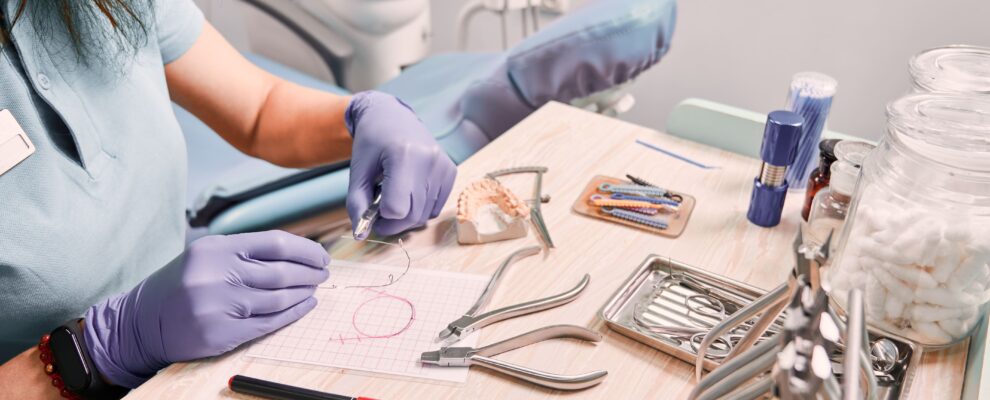The Latest Advances in Dentistry for 2024

In the ever-evolving field of healthcare, dentistry is not left behind. It is crucial to keep pace with the technological advancements that are revolutionizing dental care. This year, 2024, has already witnessed breakthroughs that are set to transform the way we perceive oral health.
This article aims to guide you through these advances in dentistry for 2024. We will delve into the specifics of how these new tools and technologies are enhancing diagnostic capabilities, making treatments more personalized, and improving patient comfort and satisfaction.
How Artificial Intelligence (AI) is Improving Diagnostics in Dentistry
Artificial Intelligence has made a significant entry into the realm of dentistry, particularly in diagnostics, offering a new level of precision and efficiency. AI in dentistry is revolutionizing the way oral conditions are diagnosed.
Improved Diagnostic Capabilities
The use of AI applications improves diagnostic capabilities, enabling early detection of various oral conditions. Through machine learning algorithms, AI can identify patterns and anomalies from dental images that may not be immediately apparent to the human eye. This technological advancement aids in increasing accuracy and minimizing the margin of error during diagnosis.
Enhanced Dental X-ray Analysis
AI plays a crucial role in enhancing the analysis of dental X-rays. AI-powered tools can evaluate radiographs with speed and accuracy that surpasses conventional methods. By identifying signs of decay or disease much earlier, these tools assist dentists in providing timely interventions.
Predictive Oral Health Care
The potential of AI technology extends beyond diagnosis to predictive healthcare. AI systems can analyze a patient’s oral health data to predict potential issues, such as susceptibility to gum disease or tooth decay. This forward-thinking approach enables proactive prevention strategies, ensuring optimal oral health for patients.
How 3D Printing is Transforming Dentistry
The field of dentistry has undergone a major transformation thanks to the emergence of 3D printing technology. This innovative approach has had a significant impact on the creation of dental implants and orthodontic devices.
Benefits of 3D Printing in Dentistry
1. Precise and Durable Dental Implants
With 3D printing, dentists can now create dental implants that are both accurate and long-lasting. These implants are designed to fit perfectly with the patient’s unique oral structure, resulting in improved comfort and durability.
2. Customized Orthodontic Devices
Another area where 3D printing has made a difference is in the production of orthodontic devices. Dentists now have the ability to design custom-made devices right in their own clinics. This not only ensures a better fit but also contributes to more effective treatment outcomes.
3. Faster Turnaround Time for Dental Procedures
One of the major advantages of using 3D printing technology in dentistry is the reduced time it takes to complete dental procedures. Unlike traditional methods that often required days or even weeks, 3D printed dental components can be fabricated within hours. And despite the quicker production, the level of accuracy remains high, which is crucial for delivering top-notch dental care.
5. Advancements in Dental Sedation Techniques
Recognizing the importance of patient comfort and anxiety management in dental procedures, advancements in dental sedation techniques have significantly improved the overall patient experience. By utilizing sophisticated sedation methods, dentists can ensure that patients remain relaxed and pain-free, which is crucial for both their physical and emotional well-being.
Types of Sedation Options:
- Inhaled Minimal Sedation: Often referred to as “laughing gas,” this method involves breathing nitrous oxide combined with oxygen through a mask. It helps patients relax and typically wears off quickly.
- Oral Sedation: From minimal to moderate levels, oral sedation is administered through pills. It allows patients to feel drowsy but still awake, and sometimes may even result in patients falling asleep during the procedure.
- IV Moderate Sedation: Administered through a vein, this technique works more quickly. It allows dentists to continually adjust the level of sedation.
- Deep Sedation and General Anesthesia: This renders patients either almost unconscious or totally unconscious (deeply asleep) during the procedure. They cannot be easily awakened until the effects of anesthesia wear off or are reversed with medication.
Each method presents unique benefits tailored to different procedure complexities and patient anxieties. Dentists consider factors like medical history, the anticipated duration of procedures, and individual patient needs when selecting an appropriate sedation option. With these varied approaches, dental care becomes more accessible for those who might otherwise avoid treatment due to fear or discomfort.
Innovations in Cosmetic Dentistry
Cosmetic dentistry is constantly evolving, bringing new possibilities for people who want to improve their smiles in a way that looks completely natural. The latest trends and techniques focus on combining artistic skills with dental knowledge to create results that are not only beautiful but also functional.
The Latest Trends in Cosmetic Dentistry
Here are some of the most exciting innovations in cosmetic dentistry right now:
Digital Smile Design (DSD)
This cutting-edge approach allows dentists and patients to work together in designing the perfect smile. Using advanced software, dentists can create virtual simulations of how different treatments will look on a patient’s face. This helps patients make informed decisions about their smile makeover before any work is done.
Veneers
Veneers have been around for a while, but recent advancements have made them even better. New materials like lithium disilicate are incredibly strong and lifelike, allowing dentists to create veneers that are thinner and require less preparation of the natural teeth.
Gum Contouring
For people with gummy smiles or uneven gum lines, gum contouring can make a big difference. Traditionally, this procedure involved surgery and sutures. However, lasers have revolutionized gum contouring, making it less invasive and more precise. Now, dentists can reshape the gums with minimal discomfort and downtime.
Innovations in Teeth Whitening
In addition to these advancements in smile makeovers, there have also been improvements in teeth whitening treatments. Here are two notable innovations:
LED Accelerated Whitening
This modern technique uses a special LED light to activate the whitening gel applied to the teeth. The light energy helps speed up the chemical reaction, making the whitening process faster and more efficient. Patients can enjoy a brighter smile in just one visit to the dentist.
Enamel Microabrasion
Some stains on the teeth are resistant to traditional bleaching methods. In such cases, enamel microabrasion can be a great alternative. This procedure involves using a gentle abrasive material to remove the outer layer of enamel, taking away surface stains and revealing a whiter, healthier-looking tooth underneath.
A Focus on Long-Term Oral Health
Apart from these exciting advancements in cosmetic dentistry, there’s also a growing emphasis on overall oral health. Modern treatments are designed not only to enhance the appearance of the smile but also to maintain the health and strength of the teeth in the long run.
By combining aesthetics with functionality, dentists can now offer treatments that not only make your smile look better but also ensure it stays bright and strong for years to come.
The Role of AI and 3D Imaging in Advancing Dental Care
Artificial intelligence (AI) is changing the dental field by making diagnosis easier, improving treatment planning, and personalizing patient care. By combining AI with clinical practice, dentists can now use complex algorithms to analyze radiographs more accurately. This is a move towards using data to make decisions.
AI in Dentistry
Diagnostic Precision
AI algorithms are taught to find patterns in dental images, which helps find problems like cavities, gum diseases, and even oral cancers at an early stage.
Treatment Planning
With the help of AI’s predictive analytics, dentists can predict how dental conditions may progress and plan treatments that can stop them from getting worse.
Patient Care
AI systems can do tasks like scheduling appointments or following up on treatment plans automatically. This makes it easier for patients to get involved in their own care.
3D Imaging Innovations
In addition to AI, 3D imaging technologies like Cone Beam Computed Tomography (CBCT) scans have also made a big difference in dentistry. These scans provide very detailed images that help dentists make accurate diagnoses and plan treatments better.
CBCT Scans
CBCT scans show dental structures in great detail, which makes it easier for dentists to place implants correctly and do root canal treatments with fewer risks.
Workflow Efficiency
These imaging solutions work well with digital systems used in clinics, which means less time is wasted between diagnosis and treatment.
The combination of AI and 3D imaging shows how modern dentistry is always changing. Technology not only helps dentists do their job better but also makes sure patients have a good experience.
Promoting Patient-Centered Care Through Technological Innovations
The integration of these technological innovations into dental care brings several benefits for patients:
- Accurate diagnosis: AI-powered systems can analyze complex data patterns that may be missed by human eyes, leading to more accurate and timely diagnoses.
- Less invasive procedures: With advanced imaging techniques like CBCT scans, dentists can visualize the underlying structures of a patient’s mouth with greater clarity. This allows them to perform procedures with minimal damage to surrounding tissues.
- Faster recovery times: By utilizing technology that promotes precision and efficiency, dental procedures can be completed more quickly, leading to shorter recovery periods for patients.
- Increased involvement in treatment decisions: Personalized treatment plans take into account the patient’s preferences and goals, giving them a voice in their own care. This involvement can lead to greater satisfaction and better adherence to recommended treatments.
In essence, these technological innovations are more than just means to improve dental procedures; they are tools that enable dental professionals to provide humanized care that respects individuality and fosters patient empowerment.
